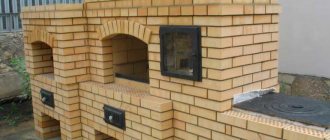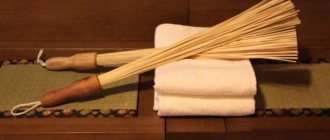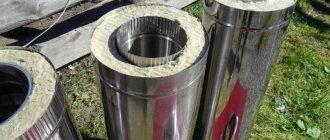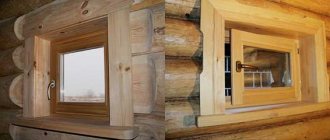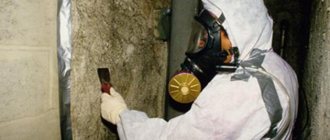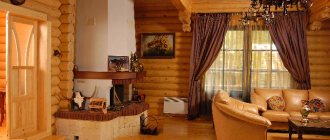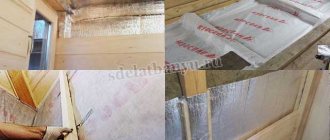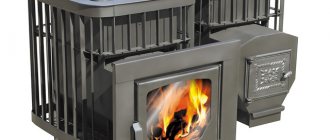Modern bathhouse with autonomous water supply
For bath procedures to bring real pleasure, it needs to be properly equipped. And first of all, make sure that the water supply system in the bathhouse is reliable and works all year round, including the coldest months.
However, not everyone needs this. For many people, the bathhouse is located at their summer cottage, and there is simply no point in investing in a complex system. Therefore, here we will consider all possible water supply schemes for a bath, from the simplest to the most functional.
Pumping water for a bath from a well
Water supply for a bathhouse from a well is the simplest and most affordable option. The daily need for water guarantees its availability in every suburban area. The water supply scheme for a bathhouse from a well is as follows:
- A submersible pump is lowered into the shaft, to which a pipeline or an ordinary garden hose is connected. Through it, water is pumped into the bathhouse.
- Instead of a submersible pump, a pump can be used, which is located next to the well or in the technical underground of the bathhouse. This method is permissible only in the case of a slight difference in height.
- The pipeline can be laid on the ground or in a trench. If there is a need for water in the bathhouse in winter, then the pipeline must be placed below the soil freezing level. All components of the water supply system, which for one reason or another are not located in the ground, must be insulated.
When making a water supply system for a bathhouse with your own hands, you need to take into account that it must have a slope towards the well. Thanks to this, the water remaining in the pipes will flow back on its own, which will eliminate the possibility of it freezing.
Baths, saunas and swimming pools
93 votes
+
Vote for!
—
Vote against!
Properly organized water supply for a bath implies an uninterrupted supply of water under constant pressure. It is with the supply of water that there are great difficulties. If heating water is not difficult - you just need to turn on the boiler or another heating option, then everything is not always clear with the influx of water. Let's consider options for organizing water supply from different sources: wells, boreholes. Let's figure out how to build a water supply system in a bathhouse with your own hands and how to connect a steam room to a dressing room.
Table of contents:
- Bath water supply options
- Summer water supply
- Advantages and disadvantages of summer water supply
- Winter water supply for baths
- Advantages and disadvantages of winter water supply
- Pumps and pipes for water supply
- Where can I get water from?
- How to make a sauna water supply with your own hands step by step instructions
Bath water supply options
The old ancient methods, when water was carried from a lake or well and poured into a barrel, from which it was then taken, are long gone. Now you can enjoy the comfort of adjusting the water supply with just one hand movement. But for everything to be exactly like this, you should approach the issue of water supply for the bathhouse with great responsibility.
First of all, the question of which water source will be used is decided. The choice occurs between three options: central water supply, well or borehole. In fact, most likely there will be no choice, but only one option available. Each method of obtaining water has its pros and cons. If it is possible to connect to a centralized water supply, questions should not arise; technically everything is clear here. Let's talk about autonomous water supply, how to get water from a well or borehole with minimal effort and maximum results. To obtain a source for water intake in a bathhouse, you must have:
- well or well;
- pump equipment;
- pipeline with wiring;
- boiler;
- crane system.
If the water source on the site is located very deep, you will have to hire specialists with equipment to drill an artesian well. And although you will have to pay a certain amount for this, the result will meet all expectations: in a couple of days you will have a source with high-quality and clean water. But if the waters pass very close, you can simply plug the pipe, install a manual pump, two valves, and you can use the water. The so-called Abyssinian well is applicable only for use in the warm season; the method is not suitable for winter.
Summer water supply
Provided that the bathhouse is used only in the warm season, the installation of the water supply will be carried out according to a simplified scheme. The pipes are laid at a depth of eighty centimeters to one and a half meters. The main thing that should not be forgotten is the angle of inclination of the system towards the well. This is necessary to ensure that water does not remain in the pipes over the winter, since freezing can damage the integrity of the pipes. To organize a water supply, you need to stock up on the necessary materials, equipment and tools. In addition to pipes, a pump and a fitting, you need to purchase a heater for washing in a bathhouse, the recommended volume is about eighty liters. You should also think about filters.
The summer method of water supply is easier to carry out, in addition to providing water for the bathhouse: steam room and shower, it is necessary to water the plants, fill the shower and provide for various needs. To connect water to the bathhouse if the summer water supply has already been laid, you can use the existing system running through the site. This will allow for a minimum of additional work and a minimum of costs.
Advantages and disadvantages of summer water supply
To set up a summer mobile water supply, it is necessary to purchase pipes for external installation of the system. This is convenient, but during cold weather the system should be dismantled. But folk craftsmen have adapted, when using rigid metal pipes, to leave them in place for the winter, having previously insulated them.
The simplest and most primitive water supply scheme for a bath using silicone hoses or remnants of metal-plastic pipes connected in series to each other. This option may be temporary during the installation of a stationary option. If a hose is used, experts advise using a product with reinforced threads. The entire system is built on a slope, which allows water to be drained as needed. And although experts have differing opinions regarding the need for a slope, it is better to do what is best. The weather can change sharply, you may not have time to dismantle the system, but with a tilt you can drain the water and not worry about the integrity of the entire structure, and be free to calmly assemble the parts until the next season.
If the water comes from a well, it is necessary to equip the system so that the water drains there. To do this, install taps and a switch. All these measures will help protect the system from destruction and failure.
Winter water supply for baths
This water supply option must be approached very responsibly. The usual option with deep laying of pipes in the ground does not quite work, since the bathhouse is a non-residential premises and is used only occasionally. This means that the slightest remaining water will freeze and disable the system, because the room temperature will drop to the street temperature.
To completely eliminate breakdowns, there should be no water in the system. To do this, you can use a vibration pump from a water source with a check valve. It works like this: after the pump is turned off, the water flows out of the pipes and does not linger anywhere. Installation of cranes or other additional equipment is not necessary. With this option, there will be no problems with the water supply of the bathhouse.
You can also use the option of adding heating cables to the pipes. The option is expensive and not always reliable for the reason that an emergency shutdown of the lights will reduce all efforts to zero. With this option, it is necessary to install uninterruptible power supplies, which also costs money.
Many masters use various options and schemes to ensure that water flows without problems, but not everyone achieves the result. Therefore, if a bathhouse is used in winter, it must be heated as a dwelling all winter or everything must be drained down to a small drop, which is also not entirely realistic. Therefore, in winter you can refuse to use the bathhouse completely.
Advantages and disadvantages of winter water supply
The ability to use a bathhouse in winter is a huge advantage, but as already mentioned, arranging such an opportunity requires time and material costs. Schematically, the algorithm for constructing water supply can be represented as follows:
- if there is no water source on the site yet, you should carefully consider the most optimal place and drill a well or dig a well;
- the next stage is the installation of an external water supply system: trenches are dug and a pipe system is installed, it is advisable to additionally insulate them, for this expanded clay is poured into the trenches or mineral wool is laid, the depth of the pipes is below the freezing level of the soil;
- after this, pumping equipment, filters, and a water tank are installed;
- the next stage is the installation of a pipe system inside the bathhouse, connecting vertical and horizontal pipes;
- The last step will be connecting the plumbing equipment and checking the functioning of the system.
For the smooth operation of the pump, on which the flow of water depends, the following main points should be taken into account:
- power;
- safety;
- well size;
- height of the water column.
A special water heating device will heat the water. They are divided into capacitive and flow-through. The capacitive device allows you to save money and get hot water. After heating the water, the optimal temperature will be maintained. Given the high energy consumption, it is necessary to make reliable wiring in the bathhouse. In severe frosts, to avoid pipes from freezing, the water must be drained. The disadvantages of this option include the need for additional costs and difficulty in operation. But if all the requirements for winter water supply are met, then you can enjoy the delights of the steam room at any time of the year and in any weather.
Pumps and pipes for water supply
We won’t talk about centralized water supply; everything is simpler and quite clear there. As for autonomous water supply systems, regardless of the water source option: a well or a well, it is necessary to install a pump for water supply. This is a very important question; you need to choose the equipment correctly.
It is necessary to start choosing equipment not with the brand or power, but with the type of pump. You need to decide which motor to take: deep-sea submersible or surface. It is very important to submit the water to a laboratory for chemical testing: drinking water or industrial water, whether there are impurities and what they are, to find out the chemical composition of the water. This is necessary in order to understand the peculiarities of filter devices.
Calculating the debit of the water source and the volume of water consumption will allow you to choose the right pump. Surface pumps can be:
- vortex - with the ability to increase pressure, for shallow sources of water;
- centrifugal - for wells and not very deep wells and natural sources of water.
Submersible pumps come in several types; they are installed at sufficiently deep sources:
- submersible motor for wells;
- submersible motor for wells.
A submersible pump better satisfies the needs for water, volume and pressure of the water column.
Having considered pumps by submersion type, let's focus on the design types:
- piston;
- centrifugal;
- turbine;
- rotary;
- vibration.
If there is an option to use either submersible or surface, compare their capabilities and characteristics to decide. The main thing that can be said about the surface motor:
- easy to maintain and operate;
- requires the installation of a suction and discharge pipeline;
- and although the stated suction depth is ten meters, in practice it is no more than seven;
- at the first start, as well as after downtime, it is necessary to fill with water;
- long work without a break can result in overheating and breakdown of the pump;
- works effectively only for summer water supply;
- Quite noisy in operation.
A deep-sea or submersible pump is characterized as follows:
- it is necessary to systematically lift for maintenance and repair;
- aimed at pumping;
- operates from a depth of ten meters;
- does not overheat, since a layer of water reliably protects the device;
- does not require preservation;
- works silently.
As for pipes, metal-plastic pipes are considered the most optimal.
Where can I get water from?
The source of water supply is the basis of the entire water supply system. Aquifers can be divided into the following main categories:
- the upper water layer is at a depth of about four meters, the maximum filling is achieved after precipitation or in the spring, when the snow melts, the quality of the water is industrial, not suitable for drinking and cooking;
- underground water – the layer is constantly filled with water, the depth of water passage is ten to twenty meters;
- artesian water - located between layers, often under pressure, clean water located at a depth of about fifty meters.
You can take water to supply a bathhouse from a regular well, an Abyssinian well, an artesian well, or a filter well.
A well is an economical option with a simple design. The depth of the wells reaches twenty meters, depending on the occurrence of layers of water. The advantages of this option include:
- ease of use;
- low cost of construction;
- durability of service;
- constant water supply.
The disadvantages of the well are as follows:
- high probability of entry of foreign objects and representatives of the animal world;
- small volume of water;
- danger of pollution from the upper water layer;
- needs to be cleaned and treated with disinfectants;
- there is a possibility of silting.
The Abyssinian well is a source with a depth of four to fifteen meters. The advantages of this option include the following:
- this structure can be erected in the basement;
- speed in construction;
- easily restored;
- sometimes there is no need to install a filter;
- the structure is sealed, protected from the ingress of foreign objects;
- the service life reaches up to thirty years;
- high performance.
The disadvantages of the structure are as follows:
- It is often difficult to select a pump;
- high risk of siltation;
- It is not possible to make a structure of this kind on every soil;
- when connecting several points of water consumption at the same time, the pressure decreases.
A filter well, as a rule, reaches a depth of no more than twenty-five meters. Drilling such a well is economically less expensive than an artesian one, but it will function for no more than two decades. The strengths of this design include:
- good water composition;
- ease of construction;
- construction speed.
The disadvantages of a filter well are the following:
- it is necessary to systematically pump water;
- low water yield in winter.
An artesian well is very deep, it can reach fifty meters. Drilling will require large expenses, as special equipment is needed. But the quality of water and the durability of the structure will cover all costs. The advantages of the well include the following nuances:
- constant water level;
- protected from foreign objects and organisms;
- can cover several houses;
- long service life;
- does not silt when not in use.
But it should also be said about the disadvantages:
- permits are required for drilling;
- water quality may be poor as a result of oversaturation with certain elements;
- high cost.
If you have a choice, decide which source of water you need.
How to make a sauna water supply with your own hands step by step instructions
To summarize all of the above, we can highlight the main stages of development:
- development of a scheme, planning and purchase of equipment and material;
- marking the terrain, digging trenches for pipes;
- measuring the depth of the water source;
- immersion of the pump and intake pipe;
- pipe connection;
- insulation of the pumping station;
- installation of pipes in the bathhouse;
- system connection.
You can make plumbing in a bathhouse yourself, the main thing is to take into account all the tips and recommendations of experienced craftsmen. If you still have questions about how to do everything correctly yourself, watch the video instructions for installing water supply in a bathhouse.
Supplying water to the bathhouse from a well
The water supply system for a bathhouse from a well is no fundamentally different from the water supply system described above. The only difference is that the well is much more difficult to develop, maintain and operate.
The task of installing a water supply system in a bathhouse will be greatly simplified if the site already has connections to a water source, for example, for pumping it into the house. In such a situation, you will have to join the existing pipeline.
It would not be superfluous to make an additional starting system for the pump so that it can be turned on from the bathhouse.
Video description
This video clearly shows the features of installing a valve drain:
In areas with frosty winters (from -20 C), it is recommended to install a valve drain for water. The diagram is mandatory when supplying water to a bathhouse that does not have constant heating and is used seasonally. The procedure involves a strict sequence of actions:
- A trench is created under the main pipe using a garden auger. In this case, the depth of the trench is set at least 0.5 m below the freezing point.
- A plastic elbow in the shape of the Latin letter U is soldered into the pipe located above the well. A hole is drilled in the lower part of the product and a fitting is inserted.
- The lower part of the well is covered with sand. A hose is placed on the fitting, the end of which is covered with a protective geotextile cover. In this case, the lower part of the hose must have free access to the sand pad.
The creation of such a system will allow excess water to be drained into the ground. When the valve is closed, the remaining water will go into the ground through the drain elbow. Moreover, if the well is located outside and the water freezes, due to the drainage of excess moisture, the pipes will not burst.
Valve water drain Source ytimg.com
Important! When forming a valve drain, the depth of the water layer must be taken into account. If it is at a minimum distance from the surface, the indicated technique is not used. This is due to the high risk of groundwater pollution.
Insulation and pump connection
One of the most reliable ways to make water supply in a bathhouse so that it does not freeze in winter is to insulate the water supply outlet areas. Any thermal insulation material that can prevent heat loss will do. In addition, it is recommended to insulate the pipes directly, especially in regions with cold winters. You can do this using:
- Creating an insulated zone around the pipe. The easiest option is to use sand. It will not only create a barrier to prevent water from freezing in the pipes, but will also reduce the earth pressure on the pipeline.
- Laying the heating cable along the length of the pipeline. It operates from the electrical network, ensuring a uniform supply of heat.
Pumping equipment connection diagram Source septik.guru
Pumping station
How to bring water to the bathhouse? Where is it better to take water from: a well or a borehole? For the most part, the last question is unimportant. Both options are not completely comfortable. An ideal solution to the existing problem would be to install a full-fledged pumping station.
This is a labor-intensive process that will take a lot of effort and time, but there will always be water in the bathhouse, house and other buildings located on the plot. The operating principle of the pumping station is simple:
- Water is pumped from a well or well into a special container, the volume of which is calculated based on individual needs. As a rule, a tank with a capacity of 300–500 liters is sufficient.
- Next, the water flows to the place where the tap was opened. The redistribution of water is the responsibility of wiring, the installation of which is carried out at the discretion of the owner of the house.
- When the water level in the tank drops to a critical level, the pump is activated, replenishing the loss.
The water tank and pump must be installed in a room where the temperature does not drop to sub-zero values. The tank must be installed so that its lower part is higher than any of the taps in the system. The ideal solution could be the attic of a house or bathhouse.
The pump can be installed under the floor or in any other place. If possible, it is better to make a separate room for the pump so that the noise it makes during operation does not get on your nerves.
How does it work
The equipment consists of a pump (any type suitable for your conditions), a tank for storing water reserves and control sensors. The comfort level of the system is largely determined by the type of tank used. It happens:
- with storage tanks;
- with hydraulic accumulators.
A storage tank is a regular container in which the water level is controlled by a float. The level rises and the pump turns off; when it drops, the pump turns on. But such a system provides very low pressure. It depends on the height difference that you managed to provide. Due to low pressure, heaters and other household appliances cannot be used. Although, if you install it high enough, you can create a height difference sufficient to take a shower. The second unpleasant detail of using such a tank is that if the float mechanism malfunctions, there is a real threat of flooding the house. This problem is solved by installing a discharge pipe, but the system is still not reliable enough.
Sectional view of a membrane tank for a pumping station
More modern modifications of pumping stations use hydraulic accumulators. They allow you to create and maintain stable pressure. This system also allows you to turn on pumping less frequently, which extends the life of the equipment.
Hydraulic accumulators in pumping stations are membrane-type tanks. In it, the container is divided into two sectors by an elastic membrane. One part contains gas (initially it is under some pressure), water is pumped into the second. There is also a sensor that monitors pressure. It sets the upper and lower pressure limits.
When water is pumped in, the membrane in the tank stretches, compressing the gas and creating even greater pressure. When the upper threshold set on the sensor is reached, the pump turns off. At the same time, a certain pressure is also created in the water tank. If a tap is open somewhere, water is supplied with good pressure to the distribution point. The volume of water decreases, the pressure on the membrane decreases. When the lower threshold value is reached, the relay is triggered and the pump is turned on, increasing it again.
This system allows you to maintain a stable pressure no matter how many taps are open. Therefore, when installing equipment with a membrane water tank, you can use water heaters of any type, as well as automatic washing machines and other household appliances that have water pressure requirements.
Differences between winter and summer water supply
In order for there to be enough water in the bathhouse and the plumbing to work properly, its installation must be carried out taking into account climatic conditions. If the bathhouse is located on a summer cottage and is used exclusively in the summer, then it is enough to take an ordinary pump and hose. To prevent the latter from being damaged during operation, it can be slightly buried - to a depth of 30–50 centimeters.
Before storing the bathhouse for the winter, the pump must be removed, and the hose can be left in the ground. According to the rules for installing a water supply system, the intake point must be lower than the place to which the water is pumped. All the liquid will flow down from the hose, and there will be nothing to freeze in it.
Water supply to a bathhouse in winter is a more complex process. The main conditions for installing a water supply system are the placement of pipes at a sufficient depth and their insulation, provided they lie close to the surface.
For a bathhouse that is not used only for its intended purpose and is heated in winter, the installation of water supply is significantly simplified. Otherwise, it is necessary to consider systems for draining water from the heat exchange system and other containers.
Cream in a water bath
Protein cream can also be prepared in a water bath. It will even be a protein custard in a water bath, to be more precise.
Take:
- 3 raw proteins
- 150 g sugar
- half a teaspoon of citric acid
- half a packet of vanilla
Further:
- Whisk all ingredients thoroughly in a small saucepan.
- Place it in a large saucepan of boiling water. Make sure that their bottoms do not touch.
- Beat the cream in a water bath for 10 minutes until it becomes very thick.
- Remove the saucepan from the water and whisk the cream for a couple more minutes.
- The gorgeous white thick cream for the cake is ready.
Cream
Water supply system layout
Running water into the bathhouse is half the battle. It is equally important to do the wiring correctly. For a bathhouse that is not heated on a permanent basis, the installation of the pipeline should begin with the installation of a drain valve. It must be placed in close proximity to the sewerage system or completely removed beyond the perimeter of the building. The drain valve should be located at the lowest point of the entire system.
After the tap, the installation of the water supply system for the bath is carried out in any order. Branches from a common pipe can go in any direction. It all depends on the number and types of plumbing installed in the bathhouse. The consumer connection diagrams are arbitrary. They can be either parallel or sequential.
Installation of internal pipes
Using a compression coupling, the PVC pipe is transferred to polypropylene. Next, a shut-off valve is installed that blocks the access of water to the street. Then another tap is installed in front of the coarse filter at 100 microns. After the filter, a water supply tap to the heater is installed in a pipe with a diameter of 25 mm. Two pipes with hot and cold water come from the heater. Shut-off valves are also installed on them. The lowest point of drainage is the faucet mixer. This type of water supply is the most resistant to freezing.
Hot water supply
Particular attention should be paid to heating the water. Hot water is always needed in the bathhouse.
There are many ways to heat water in a bathhouse - from primitive ones, which involve installing a container of water in close proximity to a heat source, to economically beneficial ones (installation of a heat exchanger). Popular methods of heating water need to be considered in detail.
The most common way to heat water in a bathhouse is to install a boiler. It has one significant drawback - excessive energy consumption, but its ease of installation is captivating. All you need to do is select a suitable installation location and install the pipes.
It is worth remembering that the presence of a boiler implies a large consumption of water, but if there is a full-fledged pumping station, then this is not a problem.
The boiler is installed in the shower room. This saves pipe consumption. If there is not enough space in the shower room to install a boiler, then it can be moved to the dressing room.
If there is a need to reduce the cost of operating a bathhouse, then you can make a heat exchanger. Cold water will be heated due to thermal energy, which in a normal situation “goes down the pipe.” How to make a heat exchanger? The easiest way to install a heat exchange system is to use a coil that is installed on top of the chimney pipe.
The disadvantage of the heat exchange system is that the pipes will have to be laid at a fairly large distance: from the stove to the shower room and back, since water must circulate in the system.
It should be clarified that hot water taps should be located below the source. A heat exchange system in which the water tank is located in the attic is much more practical than a boiler installed indoors. Of course, we are talking about standard water heaters that are not equipped with a distillation device.
How to brew herbs in a water bath?
As mentioned above, a water bath for brewing herbs is of the highest quality. For any infusions and decoctions of herbs, you should only use glass or enamel containers.
Prepare 2 pans for a water bath. Fill the larger one with water and let it heat up. Place the herbs or other plant materials you need in a small saucepan. Pour boiling water over the herbs at the rate of 1-2 tbsp. l. dry herbs for 1 cup boiling water.
Place a small saucepan of herbs in a larger saucepan of boiling water. Reduce the heat slightly and simmer the herbal decoction in a water bath for about 20 minutes.
Bath heating
The heating system operates on the principle of a heat exchanger. If the bathhouse is small in size and includes several rooms (steam room, dressing room and shower room), then a heat exchange system will be enough to heat it. If the bathhouse consists of two floors, on which there are living rooms, rest rooms, etc., then you will have to install full-fledged water heating.
How to make heating in a bathhouse? It's simple:
- First you need to install the boiler. It is best to do this in a steam room, as you can attach a heater to it.
- A pipe must be removed from the boiler. Its diameter is 0.75 inches. It must pass through all rooms and return to the heating device.
- The heating system must be equipped with a drain valve, which is installed at the lowest point. The tap is needed so that the boiler, or rather the water in the system, does not freeze if heating is temporarily suspended. There should be a sewer not far from the tap, into which water can be drained if necessary.
In order for the room to heat up faster, the heating system pipeline must be equipped with a pump, due to which the water circulation is accelerated tens of times. The pump will not allow the water to freeze if the stove for any reason was not lit in a timely manner.
Pumps and pipes
On sale you can find household liquid pumps that differ in technical characteristics, design, and the presence of additional functions.
Deep
Pumping equipment that is installed in deep wells. Advantages:
- high power;
- reliability, durability;
- multi-stage protection against clogging with debris and silt.
Flaws:
- suitable for wells made of metal pipes;
- you need to install a liquid reservoir.
The Rozhdestvensky pressure tower is often installed as a water storage tank. A deep-well pump is used on the territory of a large area where it is necessary to provide clean liquid to various buildings, a large bathhouse with a house. Not suitable for wells made of plastic tubes.
Float
Simple designs that are often used by summer residents to obtain water from natural reservoirs or wells. Advantages:
- compact dimensions;
- the ability to quickly remove equipment or move it to another location;
- floats on the surface of the water and the depth of the reservoir or well is not important for it.
Flaws:
- low power;
- inability to use in winter;
- The water container must be installed under water.
Suitable for temporary use when it is possible to take water from the nearest natural reservoir.
Submersible
A device that is submerged under water to a shallow depth. It is tied with special ropes or cables that will control the depth and keep the pump at the same level. Advantages:
- power to provide a bathhouse with clean water;
- Possibility of use in summer and winter;
- reliability, durability.
If the water level is too low, the pump will begin to become clogged with dirt and silt. The fluid supply will stop.
Accumulator pumps
Modern equipment that is suitable for different purposes. Advantages:
- A mechanism is installed to automatically turn on and off, depending on pressure drops.
- There is a power regulator.
- Suitable for natural reservoirs and wells.
One of the disadvantages of pumps with hydraulic accumulators is the high level of noise that they create during operation.
Oil in a water bath
Heating the oil in a water bath is very simple. Take 1 kg of oil and do the following:
- Cut the butter into small pieces.
- Place the oil in a water bath for an hour and a half.
- We take the coagulated protein that will collect on top into a separate container. This is a great addition to porridges and pancakes. But its shelf life is not long.
- If the butter is not homemade, then it is better to throw away this protein foam. But there will be more benefits from a homemade product.
- After the specified time, strain the ghee from the sediment. This pure product can be stored for up to 10 months. And it will become a useful addition to your kitchen.

